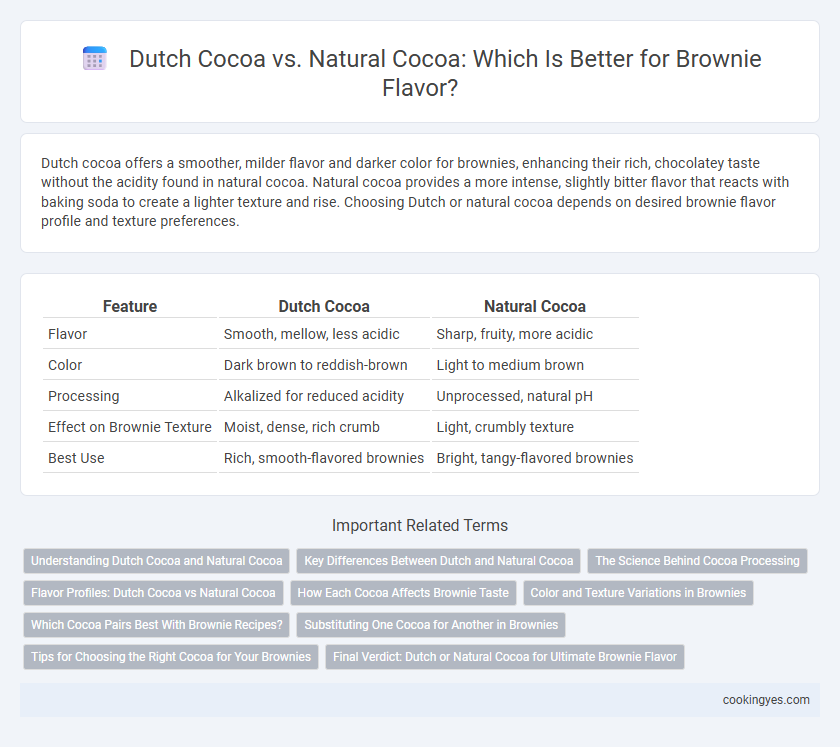Dutch cocoa offers a smoother, milder flavor and darker color for brownies, enhancing their rich, chocolatey taste without the acidity found in natural cocoa. Natural cocoa provides a more intense, slightly bitter flavor that reacts with baking soda to create a lighter texture and rise. Choosing Dutch or natural cocoa depends on desired brownie flavor profile and texture preferences.
Table of Comparison
| Feature | Dutch Cocoa | Natural Cocoa |
|---|---|---|
| Flavor | Smooth, mellow, less acidic | Sharp, fruity, more acidic |
| Color | Dark brown to reddish-brown | Light to medium brown |
| Processing | Alkalized for reduced acidity | Unprocessed, natural pH |
| Effect on Brownie Texture | Moist, dense, rich crumb | Light, crumbly texture |
| Best Use | Rich, smooth-flavored brownies | Bright, tangy-flavored brownies |
Understanding Dutch Cocoa and Natural Cocoa
Dutch cocoa is treated with an alkalizing agent to neutralize acidity, resulting in a smoother, mellower flavor and darker color, which enhances the rich, deep taste of brownies. Natural cocoa retains its natural acidity, offering a robust, tangy flavor that can intensify the chocolate notes but may react differently with leavening agents like baking soda. Understanding the chemical differences between Dutch and natural cocoa is essential for balancing flavor and texture in brownie recipes to achieve the desired taste and rise.
Key Differences Between Dutch and Natural Cocoa
Dutch cocoa undergoes an alkalizing process that neutralizes its acidity, resulting in a darker color and a smoother, milder chocolate flavor ideal for rich brownie recipes. Natural cocoa maintains its acidity, providing a tangier, more robust chocolate taste that can intensify flavor but may react differently with leavening agents like baking soda, affecting the texture and rise of brownies. Choosing between Dutch and natural cocoa depends on desired brownie characteristics, with Dutch cocoa offering a mellow, deep chocolate profile and natural cocoa delivering a sharper, more complex flavor.
The Science Behind Cocoa Processing
Dutch cocoa undergoes an alkalization process that neutralizes its acidity, resulting in a smoother, darker, and less bitter flavor profile ideal for rich brownie recipes. Natural cocoa retains its natural acidity, providing a sharper, more complex chocolate taste that reacts with baking soda to create leavening and a lighter texture. The choice between Dutch and natural cocoa significantly affects the chemical reactions during baking, influencing both flavor depth and crumb structure in brownies.
Flavor Profiles: Dutch Cocoa vs Natural Cocoa
Dutch cocoa offers a mellow, rounded flavor with low acidity and rich chocolate notes, enhancing the smoothness and depth of brownies. Natural cocoa provides a more intense, bright, and slightly acidic taste, giving brownies a stronger chocolate punch and a sharper, tangier profile. Choosing between Dutch and natural cocoa significantly impacts the final brownie flavor, balancing richness and tartness according to preference.
How Each Cocoa Affects Brownie Taste
Dutch cocoa provides a smoother, less acidic flavor that enhances the richness of brownies with a deep, mellow chocolate taste. Natural cocoa offers a sharper, more intense chocolate profile, lending a tangy brightness that intensifies the overall brownie flavor. The choice between Dutch and natural cocoa significantly influences the final brownie's taste, texture, and color.
Color and Texture Variations in Brownies
Dutch cocoa, treated with an alkalizing agent, imparts a darker, more mellow chocolate color and smoother texture to brownies, creating a rich, velvety crumb. Natural cocoa, being more acidic, produces a lighter, reddish-brown hue with a slightly coarser texture, contributing to a tangier, more intense chocolate flavor. The choice between Dutch and natural cocoa significantly influences the visual appeal and mouthfeel of brownies, affecting both their color vibrancy and density.
Which Cocoa Pairs Best With Brownie Recipes?
Dutch cocoa offers a smoother, mellower flavor with less acidity, making it ideal for rich, fudgy brownies that require a deep chocolate taste without bitterness. Natural cocoa, with its bright, tangy profile and higher acidity, reacts with baking soda to produce a lighter, cake-like brownie texture and sharper chocolate notes. For classic fudgy brownies, Dutch cocoa pairs best, while natural cocoa suits recipes aiming for a more airy crumb and pronounced chocolate bite.
Substituting One Cocoa for Another in Brownies
Dutch cocoa, also known as alkalized cocoa, has a smoother, milder flavor and darker color due to its treatment with an alkaline solution, making it ideal for brownies when a less acidic, rich chocolate taste is desired. Natural cocoa is more acidic and bitter, contributing a sharper, more intense chocolate flavor but may react differently with baking soda, affecting the brownie's texture and rise. Substituting Dutch cocoa for natural cocoa in brownies requires adjusting leavening agents, often replacing baking soda with baking powder, to achieve the desired flavor balance and proper batter rise.
Tips for Choosing the Right Cocoa for Your Brownies
Dutch cocoa offers a mellow, less acidic flavor that enhances the richness of brownies, while natural cocoa provides a stronger, more intense chocolate taste with a slightly tangy note. For fudgy, velvety brownies, choose Dutch cocoa to achieve a smoother texture and deeper color; opt for natural cocoa when a robust chocolate punch and lighter crumb are desired. Always consider recipe acidity and desired flavor profile to select the ideal cocoa that complements your brownie's taste and texture perfectly.
Final Verdict: Dutch or Natural Cocoa for Ultimate Brownie Flavor
Dutch cocoa delivers a smoother, less acidic flavor, enhancing the rich chocolate depth in brownies, while natural cocoa offers a tangier, more robust profile that intensifies the classic chocolate punch. Choosing Dutch cocoa ensures a balanced sweetness and darker color, whereas natural cocoa provides a brighter taste with a slightly lighter crumb texture. For the ultimate brownie flavor, natural cocoa is preferred by purists seeking strong chocolate intensity, but Dutch cocoa suits those desiring a mellow, velvety finish.
Dutch Cocoa vs Natural Cocoa for Brownie Flavor Infographic

 cookingyes.com
cookingyes.com